A few hours ago, MediaTek held the 2021 executive media conference where it officially released the flagship 5G SoC for 2022, Dimensity 9000. However, what’s so special about the Dimensity 9000? This chip comes with no less than 10 world’s firsts and will compete with flagship mobile chips like A15 Bionic and Snapdragon 8 gen1. Back in November 2019 when MediaTek unveiled its first flagship 5G SoC, Dimensity 1000, this chip had a dozen of firsts. This chip was the “world’s most advanced flagship 5G chip” at that time and it also opens up MediaTek’s entry into the high-end flagship market.

MediaTek did not follow its regular naming rules for its latest flagship processor. The company did not name this chip “Dimensity 2000”. Instead, it chose Dimensity 9000 which reflects the significant improvement in this chip.
Top 10 world’s first for Dimensity 9000
The Dimensity 9000 comes with no less than 10 world’s firsts. Let us take a look at the ten world firsts attributed to this chip
- World’s first 5G SoC that uses TSMC’s 4nm process
- World’s first 5G SoC with Cortex-X2 CPU core
- The world’s first 5G SoC with Mali-G710 GPU core
- World’s first 5G SoC that supports LPDDR5x 7500Mbps
- World’s first 5G SoC that supports 320MP camera
- The world’s first 5G SoC that supports 3-cam 3-exp 18bit HDR
- World’s first 5G SoC that supports 8K AV1 video playback
- World’s first 5G SoC that supports downlink 3 x 100MHz three-carrier aggregation
- The world’s first 5G SoC that supports 3GPP R16 uplink enhancement
- World’s first 5G SoC that supports Bluetooth 5.3
Let us now take a look at the details of some of the “world’s first” for this flagship processor
World’s first TSMC 4nm process chip
The MediaTek Dimensity 9000 was first launched using TSMC’s 4nm (N4) process. This is a better version of the previous TSMC’s 5nm (N5P) process. However, there is no official announcement of the improvements of the N4P over the N5P. However, from the recent N4P announcement, the N4P process can improve performance by 11% or 22% in energy efficiency, It also comes with a 6% improvement in transistor density relative to the N5 process. Overall, the performance of the N4P comes with a 6.6% performance increase over its predecessor. , and compared to N4, the performance can be improved. 6.6%.
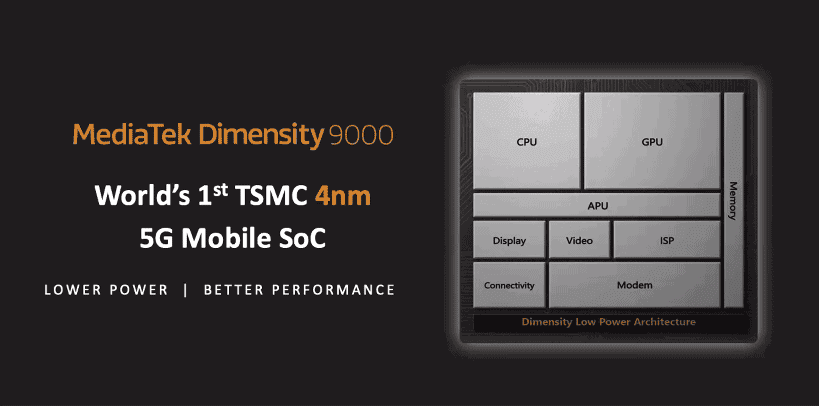
It is important to note that N4P still belongs to the 5nm family, and has 100% IP compatibility with the previous 5nm. This enables customers to use the existing design infrastructure of the 5nm process to accelerate product launches.
World’s first Cortex-X2 super core
In terms of CPU cores, MediaTek Dimensity 9000 fully upgrades Arm’s latest ARMv9 architecture. This chip is the world’s first chip to use the Arm Cortex-X2 super core. According to Arm, the Cortex-X2 has a 16% increase in integer performance relative to Cortex-X1. This chip also comes with twice the AI performance capacity. It is the best performing Armv9 CPU, which can work across high-end smartphones and laptops.
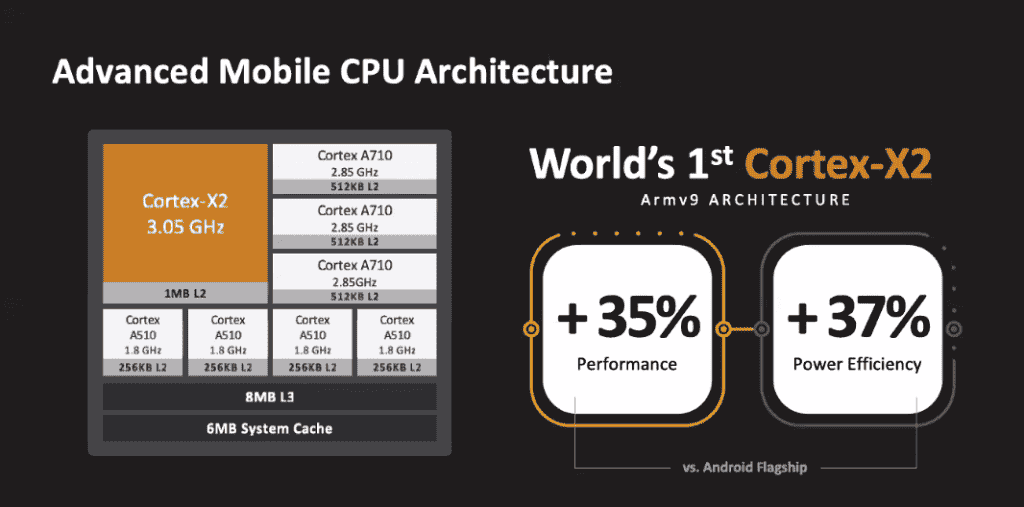
Specifically, the Dimensity 9000 CPU uses a Cortex-X2 super core with a main frequency of 3.05GHz. The chip also uses three Cortex-A710 cores with a main frequency of 2.85GHz, and four Cortex-A510 performance cores. According to MediaTek, the CPU performance of Dimensity 9000 is 35% higher than that of the current Android flagship. It is not clear if this statement refers to the Snapdragon 888. Furthermore, the energy efficiency ratio is better by 37%.

Dimensity 9000 comes with a 6MB system cache and 8MB L3 cache. It has a total of 14MB cache design, and its performance improves by 7%. Furthermore, the bandwidth consumption reduces by 25%. At the same time, the 14MB cache capacity of Dimensity 9000 hits the level of Intel notebook CPUs.
From the start-up speed test of various mainstream applications, Dimensity 9000 is 16%-55% faster than the current Android flagship CPU.
World’s first Mali-G710 GPU
Dimensity 9000 uses Arm’s latest Mali-G710 GPU. According to Arm, Mali-G710 is the most powerful GPU in Arm’s history. It is designed for high-end smartphones that want a better and longer entertainment experience. It can provide powerful graphics and computationally intensive experience, such as AAA-level high fidelity. Relative to the previous generation Arm Mali-G78 (ISO process), Mali-G710 improves its performance by 20%. This chip also improves its energy efficiency by 20%, and machine learning (ML) performance by 35%.

In terms of specific game performance, based on popular sandbox games, with a picture quality of 60 frames per second and running for 24 minutes on a 5G network, it can be seen that Dimensity 9000 and 2021 smartphone flagship processors (Apple A15) only maintained 60fps in the first 4 minutes, and then the frame rate began to decline, but the average frame rate of Dimensity 9000 was better than the latter.
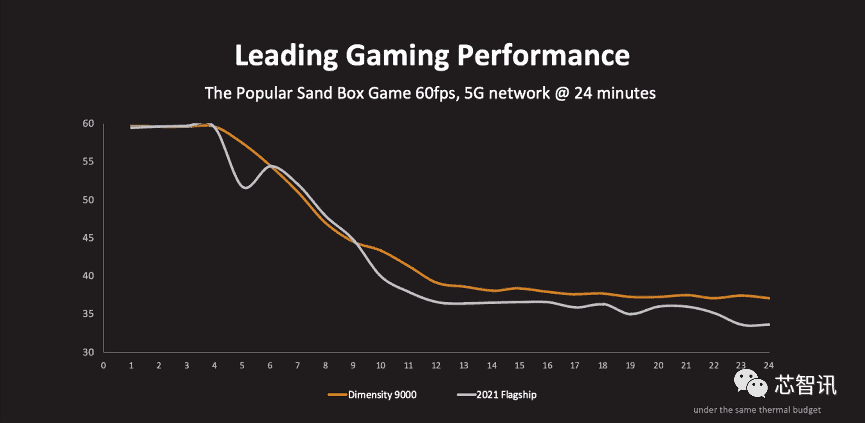
Furthermore, in various mainstream game tests, whether it is set to 120fps or 90fps, Dimensity 9000 can run at the highest frame rate and quality. In contrast, the flagship processor in 2021 can only maintain above 60fps.
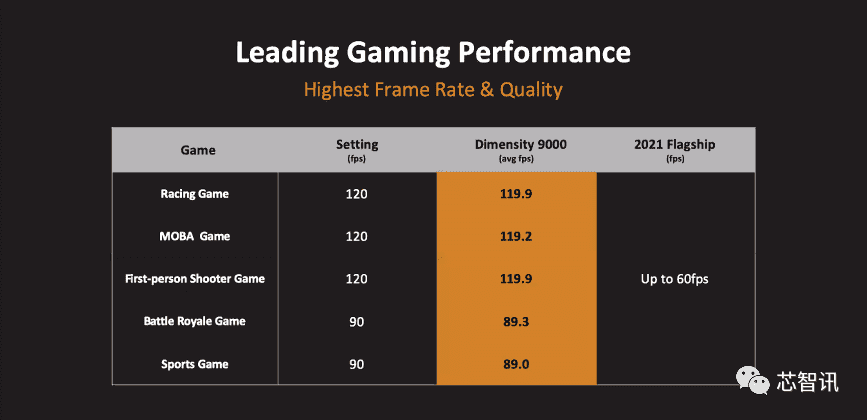
World’s first to support LPDDR5X 7500Mbps memory
In July of this year, the JEDEC Solid State Technology Association released the JESD209-5B standard for the “5th Generation Low Power Double Rate” (LPDDR5) DRAM memory. As an update to the LPDDR5 standard, it focuses on improvements in performance, power consumption and flexibility, as well as the addition of optional LPDDR5X extension specifications. LPDDR5X aims to simplify the architecture and provide higher bandwidth to support 5G enhanced communication performance and serve application scenarios ranging from automobiles to high-resolution augmented reality/virtual reality/AI edge computing.

Both Samsung and Micron have introduced new LPDDR5X memory. According to Samsung’s introduction, its LPDDR5X memory uses a 14nm process, reducing power consumption by 20%, and the rate can reach 8.5Gbps, which is about 1.3 times faster than the previous generation LPDDR5, which runs at 6.4Gbps, and has a maximum capacity of up to 64GB.
According to MediaTek’s data, relative to LPDDR5 5500Mbps, LPDDR5X 7500Mbps has a 36% increase in bandwidth and a 20% reduction in power consumption. The high performance and low power consumption bring a better experience and longer battery life for smartphones.
Dimensity 9000 AnTuTu’s running score exceeds 1 million points
Thanks to the support of TSMC’s 4nm process, Cortex-X2 super core, Mali-G710, and LPDDR5X, the overall performance of Dimensity 9000 improves significantly.
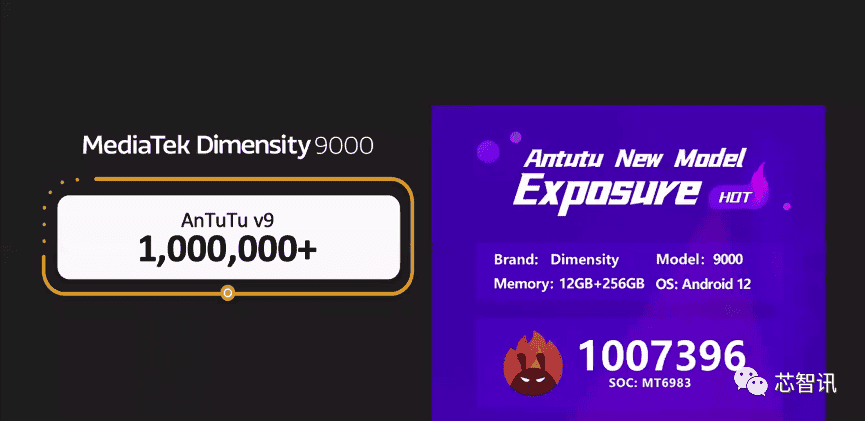
A previous report shows that the Dimensity 9000 AnTuTu running score exceeds 1,000,000 points. The previous score hit 1,002,220 points but a new score after the launch of the chip hit 1,007,396 points. As of now, this is the strongest smartphone chip in the Android camp, theoretically at least. The AnTuTu running score of the Snapdragon 888+ is more than 100,000 points lower. After subsequent optimization, this result is expected to be further improved.

In addition, there is an overall power consumption improvement in the Dimensity 9000. According to MediaTek, this new chip reduces power consumption by 40% in the standby state. For multimedia, it reduces power consumption by 65% while its power consumption reduces by 35% for gaming.
APU 5.0 is here
The AI function has been attached great importance to by MediaTek in recent years, and it has been the direction of continuous efforts. The Dimensity 9000 skips APU 4.0 and directly uses APU 5.0.
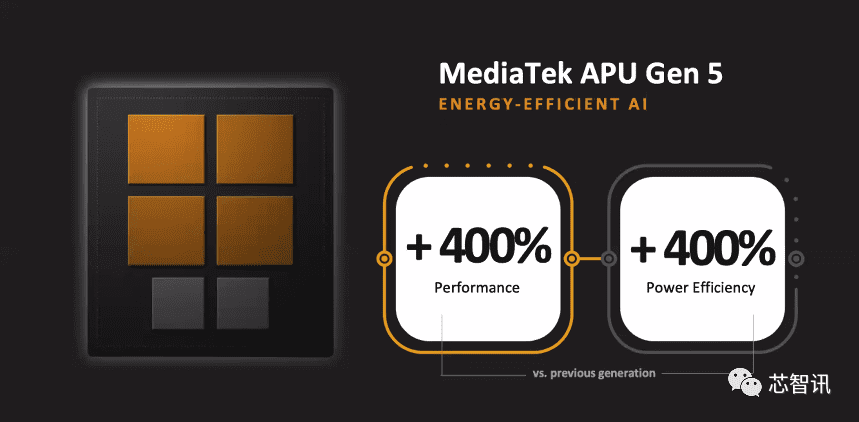
This reflects a huge improvement in AI performance brought by the new APU 5.0. According to MediaTek, the APU 5.0 of the Dimensity 9000 has 4 high-performance NPU cores and two NPU cores.
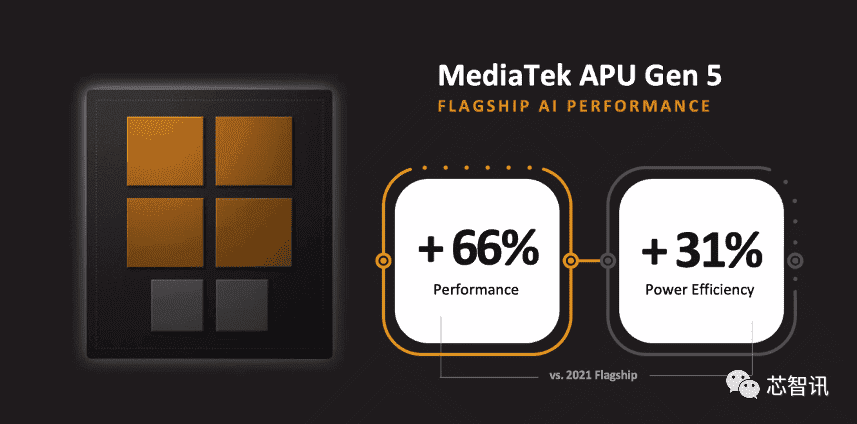
Relative to the previous generation APU 3.0, the AI performance directly improves by 400%. Also, the energy efficiency ratio improves by 400%. In comparison to 2021 flagships, the APU 5.0 AI performance improves by 66%. Furthermore, its energy efficiency also improves by 31%.
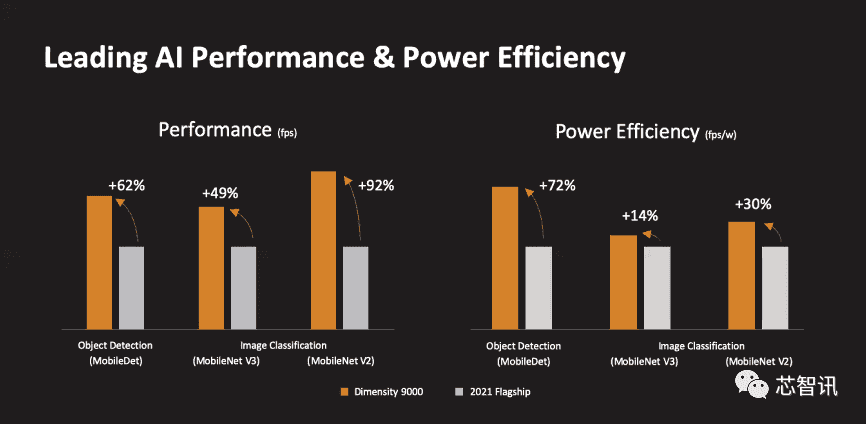
In the AI performance tests, relative to 2021 flagships, the AI performance of Dimensity 9000 increases by 49-92%. Furthermore, the energy efficiency ratio increases by 14-72%.
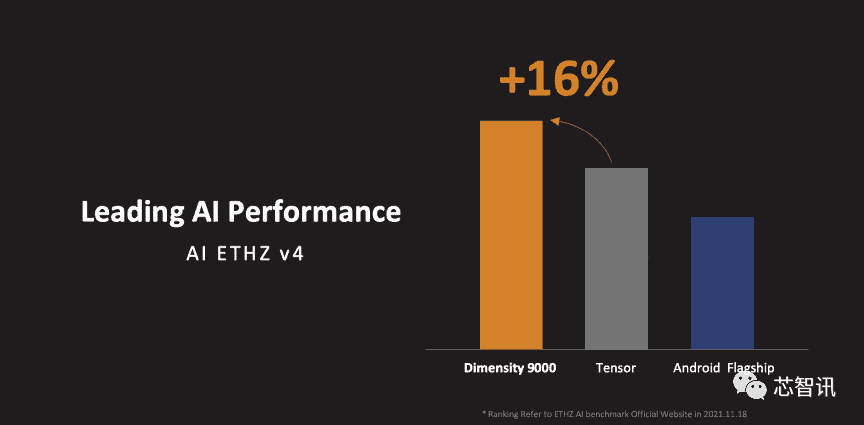
In the AI Benchmark v4 test conducted by ETH Zurich, the AI performance of the Dimensity 9000 was 16% higher than that of Google’s latest Tensor processor integrated with the edge TPU unit.
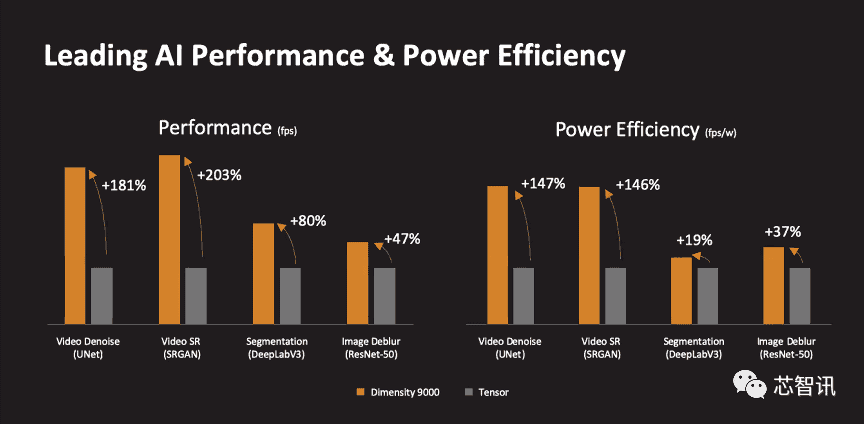
In the comparison of some other AI performance and energy efficiency test projects, the AI performance of Dimensity 9000 exceeds that of Google Tensor by 47-203%, and the energy efficiency ratio is also improved by 19-147%.

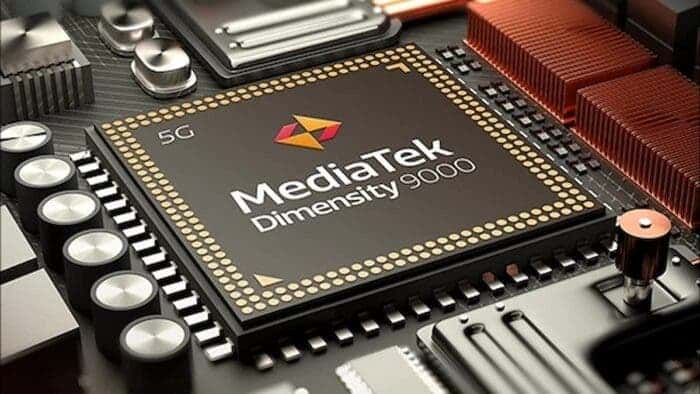








It looks very impressive , can't wait to see it in action in an actual smartphone , the competition just got tougher for qualcomm which got a big failure with the sd888, this achievement from mediatek reflects how well the company seized the oportunnity from qualcomm's mistakes and indifference, now all the owners with a phone with dimensity 9000 will be very happy